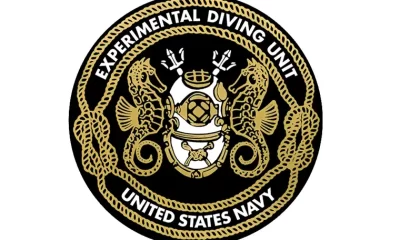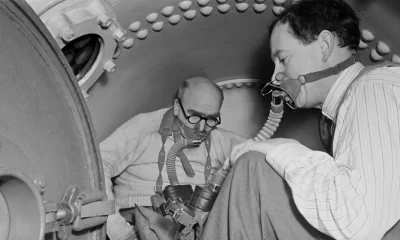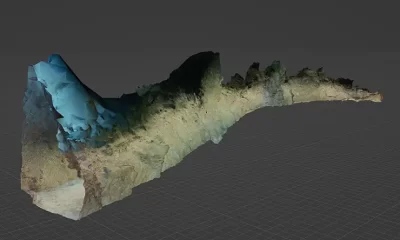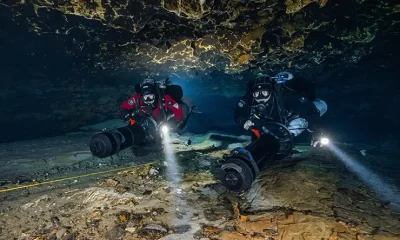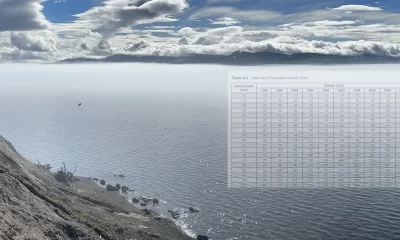
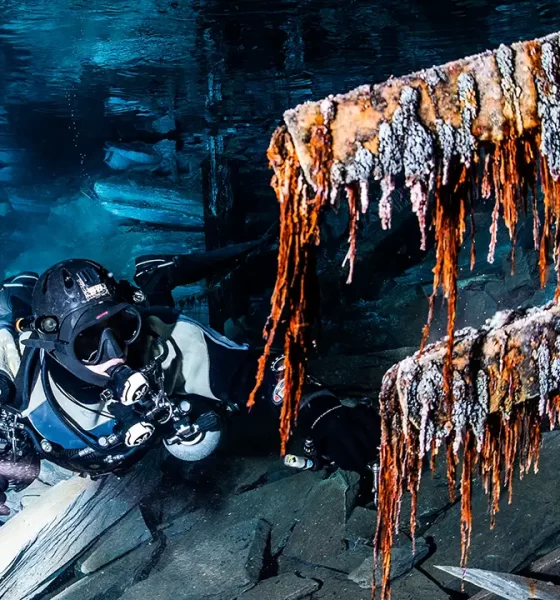
Latest Features
Mapping Belgium’s Pignon Mine: Mind the Kaboom!
Prolific author and explorer Stefan Panis and his “Mine Exploration Team” recount their recent adventures exploring Pignon Mine in Belgium. Their goal? To provide the owner of the mine with full topographic and biologic documentation, including a 3D model. They weren’t expecting to find more explosives or going tunnel—a wooden shaft begging to be explored—just as they hit their turn pressures. To be continued!
Text and images by Stefan Panis. Lead image: Diver Jimmy Wuytack staring at a rusted submerged structure.
Soon after my first exploits looking for submerged mines, I learned that I couldn’t go inside a mine without an owner’s permission. An owner can be a private person, a city, or under the control of a forester. I also learned that, during these initial exploits, a simple incident could become an expensive exploit as insurance companies would get out of paying for damage or an accident in the case of an ‘illegal’ entry of a site.
In Belgium, as is true in some other European countries, bats are a protected species—one that hibernates in the winter months. Consequently, during that time, many mining sites are closed and surrounded by fences. This deters those who would disturb them and allows the bats to hibernate. Usually, the city works with the foresters to protect these sites.
I concluded that in order to search for submerged mines I needed to begin with a team of like-minded divers and to work within the framework of the rules and in an official capacity.The growing population of divers meant more explorers of these sites and, sadly, some were violating the bats’ protected sites and causing serious trouble.
The “Mine Exploration Team” was born: a mixed team with various expert skills such as photography, videography, geology or topography. With all this combined expertise, our team was able to provide the owner of the mine with a full documentation file of the site as well as stills, video, a 3-D topography model, reports of any animal-species found living in the mine, geology details, and stability checks.
I was fortunate in that my friend and mentor Dirk Roelandt was willing to join the team. He is one of the first cave divers in Belgium, and he has enormous expertise in diving, topography, many projects and scientific expeditions for governments worldwide., Dirk could offer a wealth of information for us to learn from.

Mine Mapping
The south of Belgium is divided into cantons. Each canton has his own foresters, armed agents that are also in control of the mines because of the bats. After a successful meeting with the foresters, they agreed to grant us access to a first mine in order for us to study and to make a 3D topographical map. Therefore, in the springtime we teamed up with the agents who would give us a tour in the mine known as the ‘Pignon’ mine. We were lucky to enjoy amazingly blue water for our dive.
Nothing could be seen to give us a hint that the small entrance hid one of the largest chambers under Belgian soil (64 m/210 ft long, 28 m/92 ft high). The tour took us through small, wet corridors that would lead to huge chambers. At some point there had been a collapse, and judging from the state of the metal beams and the amount of slate on them, we identified this area as dangerous. On a later visit, Dirk actually took action..
One of our surprising finds was the rusty frame of an old bed. The agents told us that during WWII some people hid in the mine because of its remote location.
At the furthest point into the mine, we came into the big dome, where the sight of two massive underground blue lakes took our breath away! I couldn’t wait to dive in! It was also promising to see that in the dry part of the mine, a lot of artifacts had been preserved, such as huge winches and working tools, but also small ‘human’ artifacts like a shoe or an empty can of sardines, making it feel instantly personal.

Things That Go Boom
To transport all the necessary gear into the mine is a huge undertaking. Consequently, on the first exploration dives, we usually dive in an open circuit sidemount configuration with 7L tanks to make logistics a little more easy. One member of the team conducts an exploration dive to see if there is potential for further exploration and documentation on a subsequent visit.
I started my first dive near the old bed, and from the start, the slope was littered with artifacts—a shovel and a rake. Descending the shaft I discovered a large wooden box that was amazingly preserved by the cold, low oxygen water (7ºC). The shaft was not terribly deep, but the bottom shelf awaited—a nice surprise—as I could see packed crates of explosives! The paper of a box was falling apart, and I recognized the writing on the explosives, which was super cool! Note that at the end of a working day, the last two miners would typically drill some holes and stuffed them with explosives and detonated them, so the dust would settle by the next morning to extract the blocks of slate.
On my ascent I found a small room where, much to my surprise again, I found a pile of newspapers! I tried not to disturb the water as they looked very fragile, but it was amazing to read the French words on it.

The Blue Lagoon…
Working our way through narrow crooked tunnels that made us walk funny, going up and down ladders (set there by the foresters for ‘easy’ access for the yearly counting of the bats, we finally came back to the blue lagoon where Christal clear water was waiting for us. Together with Jimmy Wuytack and David Debruyne we geared up to dive in the first lake, while Dirk was our surface guard. The water was so clear that it seemed I could see endlessly.
This site was similar to the first one, with artifacts littering the site. We saw old wooden ladders, a metal oil box, and metal beams where red rusty stalactites made an amazing background for a picture and I clicked away! We descended deeper and the massive slate walls made an impressive sight. At a certain depth there seemed to be a milky layer and, together with David, who was illuminating a pile of rusted chains, this made a spooky but cool sight.
The second lake proved to be smaller but, again, a different site. There were massive blocks of slate with the most beautiful shades of different colors scattered on the bottom. For a moment I prayed that no more would fall from the ceiling while we were there.. Even though we didn’t discover kilometers of tunnels and it was not a three-hour dive, for me this is true exploration, and we took many the photographs, captured hours of video, and calculated measurements for Dirk to complete the 3D topography.

Last, but Not Least
On our way out, there was one small site left that I wanted to explore, since I could see from the surface of the cristaline water a wooden structure that got my attention. I gently slid into the water trying my best not to stir up any silt, which can easily happen superfast in a site that has lain undisturbed for nearly 100 years…
Here, also, I noticed that there were explosives spread around, and as I continued on my way I found a brass spool and the cable to detonate the fuses, which was super exciting! The wooden shaft seems stable and it looks like it’s continuing, but I checked my gauges and realized I didn’t have enough gas and it would be unsafe to continue. The secrets held by that shaft will have to wait until the next exploration!
DIVE DEEPER
InDEPTH: Mapping the Mine of Maria Concordia – My Journey into 3D By Marcin Stempniewicz.
InDEPTH: Out of the Depths: The Story of British Mine Diving by Jon Glanfield
InDEPTH:They Discovered an 11,000-year-old Submerged Ochre Mine by John Kendall
InDEPTH: I See A Darkness: A Descent Into Germany’s Felicitas Mine by Andrea Murdock Alpini
inDEPTH: Mine Over Monitor: Iconic dive sites with a shared history by Edd Stockdale

Stefan began diving at the age of 6, gradually progressing to developing an interest in wreck diving, photography and research. He has dived many wrecks in the North Sea and is part of the expedition team diving the English Channel. He has also taken part in many cave and mine dives and in 2020 was awarded a Member of the Explorers Club in New York. He is the author of numerous articles, and has co-written four books, including Diving for Treasure.


















